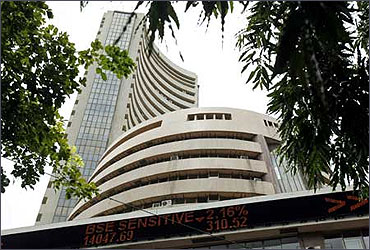 | « Back to article | Print this article |
'Sub-8% growth will bring down inflation'
Reserve Bank of India Deputy Governor Subir Gokarn says while bank non-performing assets will rise, there is no systemic risk. Here are excerpts from an interview with Manojit Saha.
What is the logic behind keeping the GDP growth projection intact?
From a demand perspective, two factors kept growth fairly robust - consumption demand and high public spending, though it is going down from its peak.
So, these are relatively insensitive to monetary policy action.
This gives us a fairly solid base for demand and therefore for growth. So, where we see moderation most dramatically is in investments.
Click on NEXT for more...
'Sub-8% growth will bring down inflation'
When do you see inflation coming down?
Two factors have driven inflation in the last few months.
One is global commodity prices and the other is the state of domestic demand. If both move downwards, it will take the inflation trajectory down sharply.
Even if commodity prices remain relatively elevated, the moderation in demand as a result of our interest rate action will bring inflation down. This is the scenario we visualise.
Is there any level of growth below which you don't want to go?
Just as we are talking about inflation, we'll start worrying if growth goes down.
The more realistic trajectory or pattern is going to be that if growth were to start slowing significantly below 8 per cent, the inflation rate will decline as well. That is how we are expecting to bring inflation down.
Click on NEXT for more...
'Sub-8% growth will bring down inflation'
The 50 basis points (bps) increase has surprised the market. Was that a conscious decision?
There was no conscious decision to surprise. We have to look at it in the context of the inflation scenario and what should be the appropriate policy response.
The scenario has changed quite significantly from the early part of the year. The combination of buoyant demand and sharp increase in commodity prices took inflation to a different trajectory.
That change in trajectory is what warranted us to change the approach starting May.
In May, we raised the rate by 50 bps. We said we have a different inflation scenario now than what we had previously. So we were following a different approach. That approach continues as the numbers still remain at that level.
The market perhaps budgeted for a 25 bps increase thinking that even if inflation numbers are high, growth is showing distinct signs of moderation and hence does not warrant a strong action. We certainly took that view in account.
But when we looked at the overall inputs that we received, we felt growth moderation was at an early stage and its impact on inflation at this point perhaps would not be as much as was needed.
So we felt the need to go for a stronger stance.
Click on NEXT for more...
'Sub-8% growth will bring down inflation'
Some analysts thought core inflation figures had stabilised.
Yes, but the figures are still above 7 per cent. Also, please keep in mind that the provisional numbers in the last few months have been significantly below the final numbers.
During your meeting today, did bankers express concern over the asset quality?
I think these are inevitable consequences of growth moderation. When demand goes down, some businesses will be affected adversely.
But they also said that while they expected to see an increase in non-performing assets, there was no systemic risk.
What was the reason for bringing down the credit growth projection?
First, there is a sectoral mix issue. There are certain sectors which are more credit intensive than others and we see those sectors driving moderation in credit growth.
Second, since interest rates are high, bankers' ability to give more credit at this rate is becoming difficult. So, that is consistent with our anti-inflationary stance. But we need a consistent picture. So, when we looked at all the aggregates we were projecting, we felt that bringing this down would be a little easier.
In June, credit growth was a little more than 19 per cent; in July, you will see it is come down below 19 per cent. It is moving along the projected trajectory.




